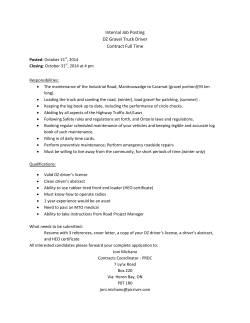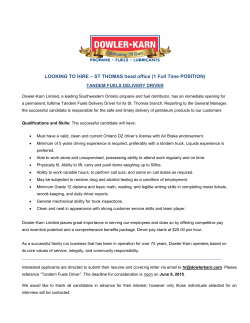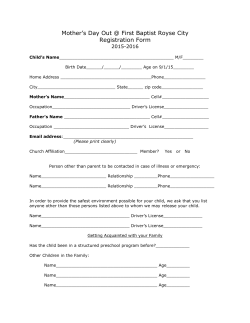
Relationship Diagram - Kilbride Consulting, Inc.
Affinity Technique (20-30 minutes) Relationship Diagram What is it? Write an ISSUE question in the form “What are all the factors related to x?” The Relationship Diagram is used to develop a non-linear representation of the factors influencing an issue. It is used to analyze complex, “messy” situations in order to identify the best leverage point for intervention in a system. Clarify roles and allow 50-60 minutes. HINT: When you are asked to “boil the ocean” this method helps you decide which molecule of water to heat up first. On sticky notes, individuals SILENTLY brainstorm answers to the ISSUE question. (10-15 minutes). HINT: Write legibly, 4-7 words/note, and one idea/note. How do I use it? The Affinity Technique is often used to generate factors to study in a Relationship Diagram. The result of combining these methods will produce a map of the interactions in a complex system that looks like this. In=2 Out=2 Place stickys on the chart, then SILENTLY group them by “likeness” or affinity. (5-10 minutes) Create 5-7 clusters adjacent to boxes A-F and outside the circle. If a sticky keeps being moved, copy and place it in both groups. In=1 Out=3 A ROOT DRIVER In=0 Out=4 Discuss each cluster and write labels to capture its’ essence in boxes A-F. (5 minutes) B F In=5 Out=0 C OUTCOME Labels need not be perfect, but should be: Each label should be at least two words. E D No more than 5-7 clusters/labels. In=3 Out=1 In=2 Out=2 Methods for Improvement Consultants © 2015 Work systematically around the circle. Begin with A&B, then A&C, A&D, A&E, A&F. Relationship Diagram (30 minutes) After completing the A’s, continue with B&C, B&D, B&E, B&F, C&D, etc. Beginning with group A, ask “Is there a relationship between A &B? If yes, ask “Which one influences the other?” Draw an arrow from the one that influences to the other. Observe the following rules: No two headed or “dotted line” arrows are allowed. There need not be an arrow (a relationship) between two items, but if there is, you must choose which one more strongly influences the other. Work for group agreement on arrows. The first round (A versus everything else) takes the longest. HINT: Determine relationships based upon the CURRENT state, i.e., “Is”, not “Should”. Count the number of incoming and outgoing arrows for each group to identify a Root Driver and Outcome. The grouping(s) with the most outgoing arrows is the ROOT DRIVER of the system, i.e., the underlying factor that influences everything else. Those with the most incoming arrows are the OUTCOMEs of the system. Focus on the Drivers. Improvement of these should positively influence the entire system. Results should be apparent “downstream” in the Outcomes. HINT: Check whether there are any arrows going INTO the Driver(s)? This may identify an even more important underlying driver of the system, though it has fewer Outgoing arrows. Methods for Improvement Consultants © 2015 On the next page is an example Relationship diagram for the Issue of "Getting Operators to Fill New Roles in a Redesigned Organization." The team then completed a Relationship Diagram to identify the key drivers for the system overall. The arrows show the result of this analysis. Two Root Drivers were identified based upon the number of Outgoing arrows: Prior to developing the Relationship Diagram, the Affinity Technique (Chapter 4) was used to generate a number of ideas on sticky notes, which were then grouped into six categories: Clear Vision for the Redesign Defined Roles & Responsibilities Training Defined Roles & Responsibilities Union Buy-In Accountability Operator Acceptance Clear Vision for the Redesign The most "downstream" Outcome is Operator Acceptance, with 5 Incoming and 0 Outgoing arrows. The team decided its next steps should be: 1. Clarify the Vision for the Redesign and use this to clearly define operator's Roles & Responsibilities. 2. Get Union Agreement on the Roles and update Training on the new Roles & Responsibilities. 3. Have supervisors hold Operators accountable for performing according to the new Roles & Responsibilities. Methods for Improvement Consultants © 2015 Example Relationship Diagram ISSUE=Getting Operators to Fill New Roles in a Redesigned Organization 1 In & 1 Out Training Root Driver #1 Defined Roles & Responsibilities Clear Vision for the Redesign 1 In & 4 Out 0 In & 4 Out Union Buy-in Outcome 3 In & 4 Out Operator Acceptance 5 In & 0 Out Accountability 2 In & 2 Out Methods for Improvement Consultants © 2015 Root Driver #2 Relationship Diagram Roles Issue: What are all the factors related to Date: Scribe: Facilitator: Timekeeper: Participants: In = Out = A. In = Out = In = F. Out = B. In = Out = In = E. C. D. In = Out = Methods for Improvement Consultants © 2015 Out =
© Copyright 2025










